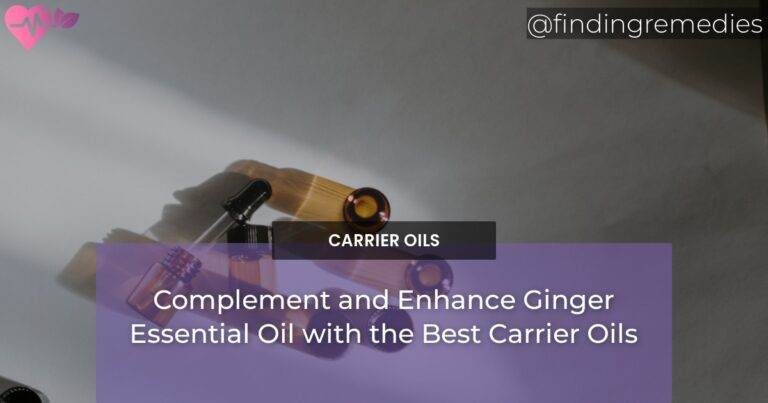Ginger essential oil is a popular choice in aromatherapy due to its numerous health benefits and versatile properties. It can be used for a wide range of purposes, from relieving nausea and digestive issues to reducing inflammation and pain. However, to maximize the benefits of ginger oil, it is important to dilute it with carrier oils that complement and enhance its effects.
Ginger Essential Oil Benefits, Composition, and Properties Overview
Benefits of Ginger Essential Oil
Ginger oil offers a range of benefits, including:
- Alleviating nausea and motion sickness
- Reducing inflammation and pain
- Improving digestion and relieving gastrointestinal issues
- Boosting the immune system
- Relieving respiratory conditions
Composition of Ginger Essential Oil
Ginger oil is derived from the rhizome of the ginger plant through steam distillation. It contains various chemical components, including:
- Alpha-zingiberene
- Beta-sesquiphellandrene
- Curcumene
- Gingerol
- Shogaol
ALSO READ
Properties of Ginger Essential Oil
Ginger oil possesses several properties that make it a valuable addition to your essential oil collection. These properties include being:
- Anti-inflammatory
- Antioxidant
- Antimicrobial
- Analgesic
- Carminative
Recommended Carrier Oils to Mix with Ginger Oil
Carrier Oils for Enhanced Aroma and Therapeutic Effects
When blending ginger oil, consider using carrier oils that not only enhance its aroma but also have their own therapeutic benefits. Some recommended choices include:
- Sweet almond oil
- Jojoba oil
- Avocado oil
- Coconut oil
ALSO READ
Carrier Oils for Different Skin Types
For topical application, it’s essential to choose carrier oils suitable for your skin type. Here are some carrier oils for different skin types:
- Argan oil for dry skin
- Grapeseed oil for oily/acne-prone skin
- Rosehip oil for aging skin
- Apricot kernel oil for sensitive skin
Factors to Consider When Choosing Carrier Oils
When selecting carrier oils, consider factors such as:
- Absorption rate
- Aroma profile
- Consistency
- Skin compatibility
- Storage stability
Carrier Oils Aroma Profiles and Absorption Rates
Aroma Profiles of Popular Carrier Oils
Each carrier oil has its own unique aroma profile. Here are the aroma profiles of some popular carrier oils:
- Sweet almond oil: Mild, slightly nutty
- Jojoba oil: Odorless
- Avocado oil: Earthy, slightly nutty
- Coconut oil: Light, tropical
Absorption Rates of Carrier Oils
The absorption rate of carrier oils determines how quickly they penetrate the skin. Here are some carrier oils with different absorption rates:
- Grapeseed oil: Fast absorption
- Apricot kernel oil: Medium absorption
- Olive oil: Slow absorption
- Shea butter: Very slow absorption
Ideal Ginger Oil Dilution Ratios
Dilution Ratios for Topical Application
When using ginger oil topically, dilute it properly to avoid skin irritation. Recommended dilution ratios are:
- 1% dilution: 6 drops of ginger oil per 1 ounce of carrier oil
- 2% dilution: 12 drops of ginger oil per 1 ounce of carrier oil
- 3% dilution: 18 drops of ginger oil per 1 ounce of carrier oil
Dilution Ratios for Inhalation
For inhalation, dilute ginger oil using the following ratios:
- 1% dilution: 6 drops of ginger oil in 1 cup of hot water
- 2% dilution: 12 drops of ginger oil in 1 cup of hot water
- 3% dilution: 18 drops of ginger oil in 1 cup of hot water
Usage Guidelines for Ginger Oil Blends
Safety Precautions for Ginger Oil Blends
While ginger oil is generally safe to use, it’s important to take certain precautions:
- Avoid using undiluted ginger oil on the skin
- Perform a patch test before using a new blend
- Consult a healthcare professional if pregnant, nursing, or have any medical conditions
Recommended Application Methods
Ginger oil blends can be used in various ways, including:
- Massage
- Inhalation
- Diffusion
- Bathing
Blending Tips and Techniques
When creating ginger oil blends, consider the following tips:
- Start with small amounts of essential oils
- Experiment with different combinations
- Keep notes of successful blends for future reference
Additional Considerations for Ginger Essential Oil Blends
Essential Oils that Complement Ginger Oil
Ginger oil blends well with other essential oils, such as:
- Peppermint oil
- Lemon oil
- Lavender oil
- Frankincense oil
Potential Synergistic Effects with Other Essential Oils
When combined with certain essential oils, ginger oil may produce synergistic effects, boosting their overall benefits. Some examples include:
- Ginger and peppermint oil for digestive support
- Ginger and lavender oil for relaxation and stress relief
- Ginger and eucalyptus oil for respiratory support
What are the best carrier oils to use with essential oils?
When looking for the best carrier oils for citronella essential oil, consider using coconut oil, sweet almond oil, or jojoba oil. These carrier oils are known for their skin-nourishing properties and can help enhance the effectiveness of citronella oil when used for aromatherapy or as an insect repellent.
Conclusion
By choosing the best carrier oils and following proper dilution ratios, you can complement and enhance the effects of ginger essential oil. Whether you’re using it for its aroma or therapeutic properties, ginger oil blends can provide a range of benefits for your well-being. Remember to consider factors like absorption rate, aroma profile, and skin compatibility when selecting carrier oils. Experiment with different blends and application methods to find what works best for you. With the right knowledge and precautions, you can enjoy the full potential of ginger essential oil blends.

